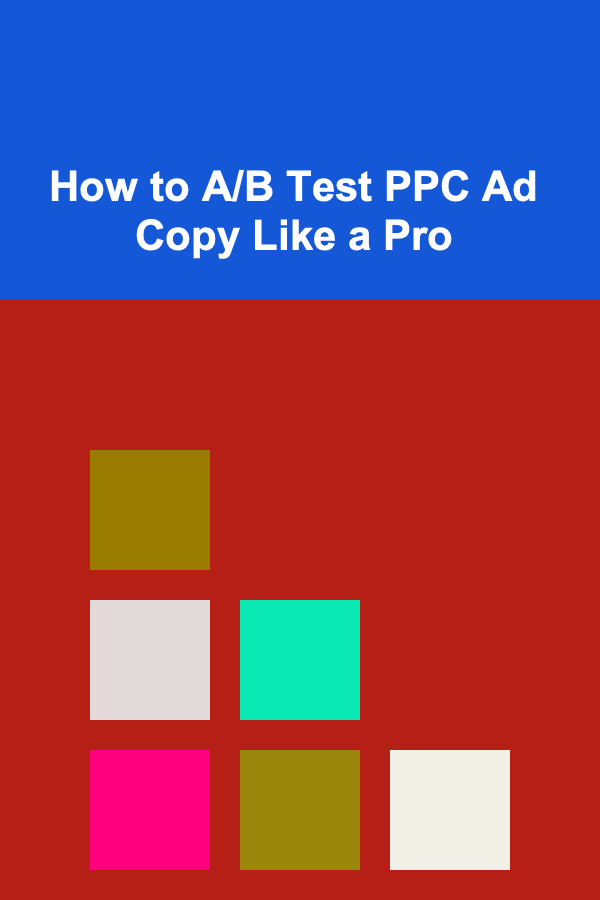
How to A/B Test PPC Ad Copy Like a Pro
ebook include PDF & Audio bundle (Micro Guide)
$12.99$9.99
Limited Time Offer! Order within the next:

Pay-per-click (PPC) advertising is one of the most effective ways to generate targeted traffic for your business. However, to maximize your PPC campaign's performance, it's essential to continually optimize your ads. One of the best ways to do this is through A/B testing your PPC ad copy. By testing different variations of your ad copy, you can identify which ones resonate most with your audience and lead to higher click-through rates (CTRs), conversions, and overall ROI.
In this article, we'll dive deep into how to A/B test your PPC ad copy like a pro. We'll cover everything from what A/B testing is, why it's important, to the step-by-step process of running effective A/B tests on your PPC ads.
Understanding A/B Testing for PPC Ads
A/B testing (also known as split testing) is a method of comparing two versions of a webpage or ad copy to determine which one performs better. In the case of PPC ads, A/B testing involves creating multiple versions of the same ad, each with a slight variation, to see which performs the best in terms of engagement metrics like CTR and conversions.
For PPC ads, A/B testing typically involves changing one or more elements of the ad copy, such as the headline, call-to-action (CTA), or description. The goal is to identify the version of the ad that drives more clicks and higher conversion rates while ensuring that all tests are statistically valid.
Why A/B Testing Is Crucial for PPC Campaigns
A/B testing is crucial for several reasons:
- Maximizing CTR: The higher your CTR, the more likely you are to attract quality traffic to your site. By testing different versions of your ad copy, you can find the best combination of words, phrases, and tones that grab your audience's attention.
- Improving Conversion Rates: Higher CTRs alone don't guarantee success if those visitors don't convert. Through A/B testing, you can determine which ad variations lead to more sign-ups, purchases, or other desired actions on your website.
- Optimizing Ad Spend: PPC campaigns typically involve a considerable investment. A/B testing allows you to make data-driven decisions, which helps you allocate your budget to the best-performing ads and improve your overall return on investment (ROI).
- Learning About Your Audience: A/B testing enables you to gain valuable insights into what appeals to your target audience. Over time, you'll learn more about their preferences, behaviors, and what messaging resonates with them the most.
- Continuous Improvement: A/B testing allows for ongoing optimization. As you gather more data, you can continue refining your ad copy to keep improving your campaign performance.
Key Elements to Test in Your PPC Ad Copy
When A/B testing PPC ad copy, you have several elements to play with. Below are some of the most important factors to test:
1. Headlines
The headline is one of the most critical elements of your ad copy, as it's the first thing users see. A compelling headline can significantly boost CTR. When testing headlines, consider experimenting with:
- Emotional vs. Rational Appeal: Does your audience respond better to emotional appeals (e.g., "Save Money Today!") or logical ones (e.g., "10% Off Your First Purchase")?
- Value Proposition: Try different ways of communicating your value proposition. For example, "Free Shipping on All Orders" vs. "Get Your Items Delivered for Free."
- Urgency: Headlines that create a sense of urgency ("Limited Time Offer!") can often perform better than more neutral headlines.
- Personalization: Using words like "you" or your customer's name (if possible) can increase engagement.
2. Call-to-Action (CTA)
The CTA is what drives action from the user, so it's crucial to get it right. Some common CTAs you might test include:
- Action-Oriented Phrasing: Compare "Shop Now" vs. "Buy Today."
- Urgency vs. Soft Approach: Test "Order Now -- Limited Time Offer!" against "Browse Our Latest Collection."
- Benefit-Focused vs. Feature-Focused: For instance, "Get Started Now" vs. "Start Your Free Trial."
3. Description Lines
The description lines give you a bit more space to elaborate on your offer. Some ideas to test here are:
- Benefit-Focused Copy: "Boost Your Productivity" vs. "Increase Your Efficiency Today."
- Social Proof: Using phrases like "Join Thousands of Happy Customers" vs. "100% Satisfaction Guarantee."
- Pain Point Identification: Try addressing the pain points of your target audience, such as "Tired of Waiting for Your Package?" vs. "Get Free 2-Day Shipping!"
4. Ad Extensions
Ad extensions are optional, but they can significantly improve the performance of your PPC ads. Common types of extensions include:
- Site Link Extensions: These are clickable links that take users to specific pages on your website.
- Callout Extensions: Short, additional text that highlights unique selling points.
- Structured Snippet Extensions: Highlight specific aspects of your products or services (e.g., "Available in 5 Colors").
You can test different combinations of ad extensions to see if they improve your CTR and overall ad performance.
5. Ad Copy Length
The length of your ad copy can affect how much information you can convey to potential customers. Test different ad copy lengths to see which resonates better with your audience:
- Short and Snappy: A concise message that immediately grabs attention.
- Detailed and Informative: A longer ad that provides more information to persuade users to click.
The A/B Testing Process for PPC Ads
Now that we've discussed the key elements to test, let's break down the process of running A/B tests for PPC ads like a pro.
Step 1: Define Your Goals
Before you begin testing, it's essential to know what you want to achieve. Are you trying to increase CTR? Improve conversion rates? Lower your cost per conversion? Setting clear goals will help you measure the success of your tests and make data-driven decisions.
Step 2: Choose One Variable to Test
To ensure that your A/B test results are valid, you should test only one element at a time. For example, if you're testing headlines, create two versions of your ad with different headlines but the same descriptions and CTAs. Testing multiple variables simultaneously can confuse the results and make it harder to determine which change led to improved performance.
Step 3: Create Your Ad Variations
Once you've selected your variable, create two variations of your PPC ad. Ensure that the only difference between the two ads is the element you're testing. For example, if you're testing a headline, make sure all other elements (description, CTA, etc.) remain the same across both ads.
Step 4: Set Up Your A/B Test
Set up your A/B test in your PPC platform (Google Ads, Bing Ads, etc.). Many platforms have built-in tools to help you split test ads. If your platform doesn't have this feature, you can manually track performance by using tracking URLs or different campaigns/ads.
Step 5: Run the Test
Let your A/B test run for enough time to gather statistically significant data. A good rule of thumb is to let the test run for at least 2-3 weeks to ensure that external factors don't skew your results. You should aim to get enough impressions and clicks to make a data-driven decision.
Step 6: Analyze the Results
After the test has run its course, review the data to determine which ad performed better. Look at the metrics that matter most to your campaign goals, such as CTR, conversion rate, or cost per conversion. If one ad outperforms the other significantly, it's time to implement the winning variation and run additional tests.
Step 7: Repeat and Refine
A/B testing is a continuous process. Once you've found the best-performing ad variation for one element, start testing other aspects of your ad copy. Over time, you'll fine-tune your PPC ads to maximize their performance.
Best Practices for A/B Testing PPC Ads
- Test Continuously: Don't stop testing once you've found a winning ad. Keep optimizing your ad copy to stay ahead of the competition.
- Run Tests Simultaneously: Test both ad variations at the same time to avoid any time-related biases.
- Keep Testing Relevant Elements: Focus on testing elements that are directly tied to user behavior and campaign goals, such as headlines and CTAs.
- Track Your Results Properly: Use tracking tools to measure performance accurately, and make sure you're testing statistically significant variations.
Conclusion
A/B testing is one of the most powerful techniques for optimizing your PPC ad copy and improving campaign performance. By testing headlines, CTAs, descriptions, and other key elements, you can identify the most effective combinations and refine your ads to increase CTR, conversions, and ROI. Remember, A/B testing is an ongoing process, and continuous optimization is key to staying competitive in the ever-evolving world of PPC advertising.
Reading More From Our Other Websites
- [Personal Investment 101] How to Use Robo-Advisors to Simplify Your Investment Strategy
- [Home Lighting 101] How to Install Recessed Lighting for a Modern Look in Your Home
- [Organization Tip 101] How to Create a Dedicated Space for Sports Equipment
- [Personal Care Tips 101] How to Use Hand Cream to Combat Excessive Hand Washing
- [Home Soundproofing 101] How to Block Out Noise in an Urban Apartment
- [Biking 101] Top 5 Benefits of Riding a Tandem Bike Together
- [Home Family Activity 101] How to Transform Your Backyard into a Kid-Friendly Oasis for Backyard Gardening with Kids
- [Organization Tip 101] How to Celebrate Your Meal Prep Successes
- [Organization Tip 101] How to Curate a Recipe Collection for Special Occasions
- [Personal Care Tips 101] How to Use Hair Gel for Styling Different Hair Lengths and Types

How to Allocate Funds for Entertainment and Leisure
Read More
How to Clean Windows for a Streak-Free Shine
Read More
How to Make Money Online as a Financial Planner: 10 Actionable Ideas
Read More
How to Organize Kids' Snacks for Easy Access
Read More
How to Upgrade Your Home's Lighting Fixtures for a Modern Look
Read More
Top Affordable Meal Subscription Services for Budget-Friendly Eating
Read MoreOther Products

How to Allocate Funds for Entertainment and Leisure
Read More
How to Clean Windows for a Streak-Free Shine
Read More
How to Make Money Online as a Financial Planner: 10 Actionable Ideas
Read More
How to Organize Kids' Snacks for Easy Access
Read More
How to Upgrade Your Home's Lighting Fixtures for a Modern Look
Read More